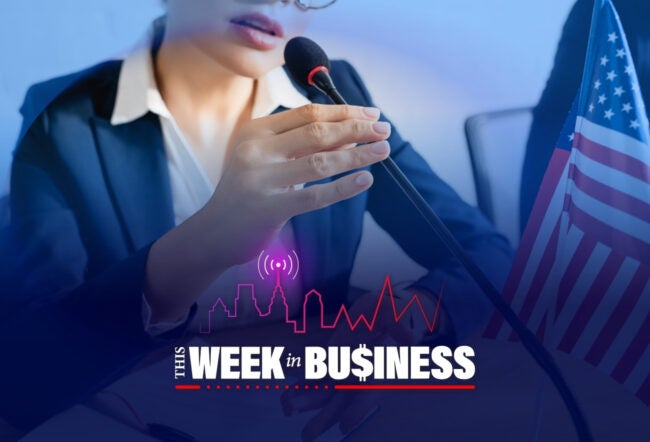Patrick Harker, president of the Federal Reserve Bank of Philadelphia, said “it’s not out of the question to still have one, possibly two” interest rate increases this year, though the recent weak jobs report has left the strength of the U.S. economy more open to questions. “We are at a point now where that jobs report gave us some pause. But I still think that the economy continues to be quite strong,” Harker noted in this wide-ranging Knowledge at Wharton interview, which took place before the U.K. vote to leave the European Union. Harker’s comments came during a two-day conference — “The Interplay between Financial Regulations, Resilience, and Growth” – sponsored by the Federal Reserve Bank of Philadelphia, the Wharton Financial Institutions Center, the Imperial College Business School and the Journal of Financial Services Research.
Harker’s views on the surprisingly weak May jobs report and potential for rate increases this year echoed those of Fed Chair Janet Yellen, who also cited financial market risks from a potential Brexit this week as notable reasons why the Federal Open Market Committee (FOMC) voted unanimously on June 15 not to raise interest rates. She reiterated many of those comments Tuesday and Wednesday before Congress. The FMOC meets again next month to reconsider whether an interest rate increase is needed now, and the next opportunity for an FOMC decision comes in September.
In Part 1 of this two-part series, Harker, a former Wharton dean, also discusses the limits of monetary policy; zero-bound and negative interest rates; the importance of education, innovation and infrastructure development for productivity; and a coming labor squeeze from Baby Boomer retirements that is threatening a slower, “new normal” U.S. growth rate. In Part 2 Harker discusses whether the Fed should be in the business of bursting asset or credit bubbles; ‘Too Big To Fail’ issues; shadow banking; fintech; and what surprised him during his first year as president of the Federal Reserve Bank of Philadelphia.
And edited transcript of the conversation follows:
Knowledge at Wharton: This is an auspicious time to have President Harker with us because just a couple days ago [June 15] the FOMC made the decision not to change interest rates — although you won’t actually be voting until 2017. Correct?
Patrick T. Harker: Yes, next year.
Knowledge at Wharton: I’m sure you have some views on it, and that’s what I’d like to ask you. How would you have voted this time around? It may be anti-climatic because as I understand the vote was unanimous. But what would have gone into your thinking, perhaps, is the better question?
Harker: A few weeks ago I gave a speech just across the street at the Constitution Center where I said that two, possibly three increases this year were not out of the question. And then we got the [May] jobs report. And I think that caused a pause, everybody stepped back a little bit to ask, “what’s going on?” It muddied the waters a little bit in my mind and here with our research staff, because it doesn’t quite add up, given everything else we’re seeing.
We are fully expecting that we will see a slowdown in jobs. As we reach full employment or maybe go lower than what the natural rate would be, it is natural that the [job growth] slows down. But we’re also seeing record job openings. The “quits” are still running high … we’re seeing other strength in the labor market.
“I think it’s not out of the question to still have one, possibly two [interest rate] increases this year.”
When you combine that with what we’re hearing through our contacts throughout the district [Federal Reserve Third District], most of Pennsylvania, and also Delaware and southern New Jersey]. And it doesn’t quite make sense. So the committee chose to not raise rates at that point. I still think … the U.S. economy … is incredibly robust…. If you step back and think about … the headwinds that we’ve been facing in a variety of ways, this is an economy that keeps chugging along. I wouldn’t say it’s robust. It’s not booming. But it keeps rolling along.
We keep adding jobs. We’re getting to a point where you will see the slowdown in the labor market a little bit. Part of the issue, by the way, with that jobs report and the unemployment rate kicking down a lot, was the participation rate dropping. And everybody saw that as an aberration.
I don’t see it that way. There’s work done here by Dr. [Shigeru] Fujita and others on our research staff where you look at the long-term secular trend of labor force participation — we’re heading toward a new normal, right, a lower level, just because of the baby boomers retiring. Although the labor force participation ticked up, it’s a bit of a stochastic process around that trend, but that trend is clear — that number is coming down.
And so we are at a point now where that jobs report gave us some pause. But I still think that the economy continues to be quite strong. If you look at inflation … we are heading toward our 2% target. Oil has solidified in terms of its price. In fact it may go up. It’s hard to predict. So we’re starting to see that transmit through the inflation numbers. And we are starting to see some wage pressures building, particularly for those who have stayed in the same job. Those folks are starting to get significant increases.
The other thing you’re hearing from contacts quite often is: People can’t find the qualified workers they need. And so there’s a bit of a job mismatch going on, a skills mismatch. There are a lot of jobs, but people can’t find the appropriate folks. You’re going to start to see that transmit through wage pressures as well. I think it’s not out of the question to still have one, possibly two [interest rate] increases this year.
Knowledge at Wharton: There’s a counter argument out there, which found itself into the news just this week. It goes something like this: The U.S. economy hasn’t returned to full productivity compared with the pre-crisis period. In the first quarter this year, GDP was about 2.2% less than potential GDP. This is the so-called output gap.
And so the idea is … that there isn’t a lot of wage-price pressure. And in the absence of that, why not err on the side of allowing inflation to creep up a little bit because the Fed has excellent tools for combating inflation? The Fed knows how to take the punch bowl away.
“But I can tell you I hear from company after company after company, they cannot find skilled workers. That’s not just the tech companies. It’s across the board.”
On the other side, if growth slows too much, and there’s been worries about deflation, not so much in the U.S but in Europe and Japan, the tools have much less traction. So that argument is why, [when it comes to] talk about raising rates this year, why don’t we wait and until we have some real inflationary or wage pressures?
Harker: So obvious everybody in this room knows that the lag from when rates go up to where we see that effect is quite long, right – ‘18ish’ months. But who knows? Maybe more, maybe less. So one argument is that if we wait too long we’re going to get behind the curve. That’s an argument that I consider, and I think it’s an important argument, but I don’t think that plays a role as much right now given what you’ve just said, where we are running below 2% [inflation target]. But we are starting to see us move toward the 2%.
First it’s important, and the committee made this very clear in the statement recently, that the 2% percent target is symmetric. Often the media and others see it as a ceiling, not a symmetric target. So you’re right. It’s okay to exceed that for some period of time as long as you don’t get significantly behind the curve, so you can’t do anything about it.
So you look at the risks. There are risks that you mentioned with the world economy — that we should wait given those risks. So there are some downside and upside risks. There’s also some risk, in my mind, of staying close to the effective or zero lower bound [zero real interest rates] for too long. There are some reasons that we want to get some headroom, away from zero, if the economy can sustain it — if it’s not damaging to the growth of the economy. And so in my mind a 25 basis point increase — it’s hard to imagine that that would have devastating effects on the economy. It will have effects, there’s no question about it, particularly transmitted through the dollar. And we do have to worry about that. But there are risks on both sides of this equation. And that’s where I have to balance off, in my own policy formulation, those two risks.
Knowledge at Wharton: When you talk about not keeping interest rates too close to zero for too long, you’re referring to the limits of monetary policy, right?
Harker: Yes.
“And so we are at a point now where that jobs report gave us some pause. But I still think that the economy continues to be quite strong.”
Knowledge at Wharton: And we’re seeing around the world that we have interest rates below zero in some places. My list shows we’ve got Germany, Austria, Denmark, Sweden, Switzerland, Japan — I might be missing one — that have rates at zero or below zero in most cases. Is this a sign that monetary policy has reached its limit?
Harker: Yes. Let’s step back and really look at one of the issues that I think most economists are very concerned about, which is our star, the neutral [federal] funds rate. It’s low, given that you have to look at policy relative to that mutual rate. Why is it so low?
And what can monetary policy do about it? Well the reality is, in theory and in practice, not much. Good monetary policy, when it’s good, gets out of the way of the real economy doing its thing. People recognize bad monetary policy. So there’s a lot of bad monetary policy. And so the question comes up: Should we, could we take rates negative? While there are some questions about the could, some legal issues and so forth, but it’s more about the should. The evidence in my mind is quite mixed on taking rates negative. I think we, as central bankers, frankly have to be humble. There’s only so much monetary policy can do. Again, when it’s good, it is facilitating the real economy, creating jobs, creating a more productive economy and so forth.
What I worry about is that we’re being asked as central bankers around the world to solve problems that are, frankly, outside our wheelhouse. Fundamentally to move our star, it’s about a host of other policies, whether it’s tax policy or labor policies. Regulatory issues more generally. A host of issues. And not just at the national level, by the way.
Look at the United States — we often think of it as a big homogenous economy. It isn’t. We have a very diverse, very different economy across this country. And so state policies, local policies matter tremendously. It’s not just national policy, which clearly matters.
“And so in my mind a 25 basis point increase — it’s hard to imagine that that would have devastating effects on the economy”
There’s a whole matrix of policies that can potentially move that mutual rate and get us out of this low interest rate, low productivity equilibrium that we seem to be in. And none of those, or very few of those, have anything to do with monetary policy. I worry a lot about that because, as some pundits have said, it’s like pushing on a rope. You could continue to take interest rates negative, but at some point if those other policies don’t kick in and if we’re not effectively looking at things….
For example, one of the arguments that’s out there that I am sympathetic to, having come from higher education, is that one of the many possible explanations for the productivity slowdown is that we just don’t have the educational attainment we once had in this country. There are many arguments that you could make for productivity slowdown, but there’s some evidence that this is true. We don’t have, what I’ll call, the tinkerers. We often think of innovation as happening by some great idea that comes out of a research lab out of a university that roars into the economy and makes a fundamental difference. That’s not the way it works. The way it works is there’s some research and then years and years and of development by what I’ll call tinkerers — people who tweak, people who turn, people who figure out how to make it better.
Knowledge at Wharton: From the bench.
Harker: Yes, exactly. And to do that we not only need a great pipeline of PhDs doing the research, but we need people with strong skills from associates degree programs and so forth that are there working with the technology, with the machines, that learn how to tinker. The evidence is overwhelming that’s true. And so it’s educational attainment all across our demographic, not just at one particular level. I have some sympathy for that argument. And so, again, that has nothing to do with monetary policy. It has everything to [do with] education policy in the country.
Knowledge at Wharton: So policymakers among all the things you cited, and I’m thinking here in the U.S. and also in Europe, either won’t or can’t — or politically can’t — use the lever of fiscal policy very well. In fact there have been [budget] cuts in Europe, quite a bit. So that’s creating problems. Here in the U.S., with interest rates so low, and as a former civil engineer, I want to ask you about the infrastructure problem because this comes up a lot. The U.S. could borrow money practically for nothing. There’s a multiplier effect that would say, if the government spends a dollar it creates $1.30 or so [in economic activity] — I think the IMF just raised that multiplier by some amount, that the multiplier effect into the economy is terrific. And yes, we have a big long-term debt, but our [immediate] problem is short term. We’ve got crumbling bridges here in Philadelphia. Every now and then a water pipe from 1875 blows up an an intersection. And so there’s no shortage of shovel-ready projects. Can that be put together? Obviously it’s a political problem but what’s your view of the right thing to do?
Harker: We are not engaged in fiscal policies as you can — we stay very clearly on our line of monetary policy. But there’s no question that an economy needs infrastructure investment to be productive. As roads crumble, as systems fail, the economy does not produce in the same way. There’s no question about that.
And the American Society of Civil Engineers has done this study for years and years now on the level of infrastructure, the quality of infrastructure in the United States. It’s not good. Just look across the landscape, it’s not very good.
There’s no question that infrastructure, properly done, can make the economy more productive. And you see this across states, where bridges are being closed. Simple things, right? Now I have to go several miles out of my way, because the bridge is gone. How exactly [can we] fund that? That’s not in my domain. But I think there’s no question that those investments, properly done, would pay off over time.
Knowledge at Wharton: So there are a lot of public good projects that could have a positive ROI.
Harker: Yes, sure.



